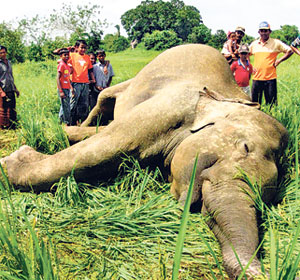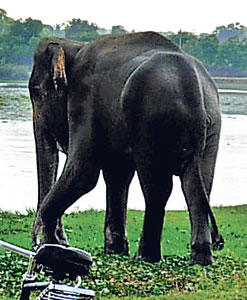Hungry elephants, deprived of food in their shrinking natural habitat, are forced to go foraging in cultivated lands and farms, and the inevitable result is conflict between elephants and humans. This conflict resulted last year in the deaths of 228 elephants, including tuskers, while at least 50 persons were killed in elephant attacks last year.
The Wild Life Department’s failure to address the situation in the human-elephant conflict is highlighted in a letter sent by the Sri Lanka Wild Life Veterinary Surgeons Association to the Economic Development Minister, Basil Rajapaksa.
 |
| A victim of the human-elephant conflict that caused the death of 228 elephants last year. |
The letter says the present system of conserving wild elephants is quite unsatisfactory.
The association has found shortcomings in the use of explosives to frighten away elephants; the electric fences put up to keep elephants out; the capture and rehabilitation of elephants, and the treating of sick elephants. All these have led to an increase each year in the number of deaths in the human-animal conflict.
“Rehabilitation of wild elephants is a must,” wildlife veterinarian Dr. Vijitha Perera told the Sunday Times.
“The current practice is to capture the elephants and release them in other areas. But these elephants soon start causing damage and destruction in the areas where they have been released. “The Lunugamvehera elephant rehabilitation centre, for example, has not been maintained, and several elephants have escaped.”
Injured and sick elephants are not getting proper treatment at the rehabilitation centres, although the centres get adequate funding, said Dr. Perera, who is also secretary to the Sri Lanka Wild Life Veterinary Surgeons Association.
“The newly built rehabilitation centre in Ritigala was built without proper planning and without consultation with wildlife experts.”
Most of the elephants that raid crops, including tuskers, have become accustomed to the sound of gunshot and firecrackers.
Moreover, repeated detonations and loud noises targeting elephants have caused hearing impairment among the animals, he said.
Electric fences, meanwhile, are proving ineffective. “Only a few of the electric fences put up around the forests are functioning, and the elephants are not afraid of the fences,” Dr Perera said. .
 |
| A fatally wounded elephant staggers away, its mouth blown up after chewing on a ‘haku patas’, an explosive hidden inside food. In Amparai. |
“Unfortunately, some elephants get into trouble when they try to pass through fences that do function. Millions of rupees are spent on these fences, but they are not being maintained. And in many areas the electric fences are sub-standard.”
Meanwhile, domestic animals, including cattle, are invading elephant country – the forest reserves – and eating up the elephants’ food resources, Dr. Perera said.
More than Rs. 120 million have been spent on driving away elephants in the North-Western part of the country.
“These allocations of money should be used properly, and more should be allocated for rehabilitating wild elephants. Just chasing them away is not the answer.”
A serious shortage of wildlife veterinary surgeons is only making matters worse.
“There are only seven wildlife vet surgeons in the country,” Dr. Perera said. “We need a minimum 15 vet surgeons.
“These experienced vet surgeons are getting step-motherly treatment, and that is why they are leaving the Wild Life Department. And new vet surgeons are not keen to join the department.” |



